Jspartans26
Chirping
- Oct 22, 2020
- 39
- 59
- 79
When I was locking up my chicken coop for the night, I noticed one of my chicken’s feet were swollen, and I think it may be the early stages of bumble foot. She’s also the only one that won’t go up on the roost on her own at night. I had read that if caught early enough, an epsom salt bath may help, and I had thought of adding essential oils as well. Would onguard or lavender be safe to add into the bath? And are there any other treatment options?







